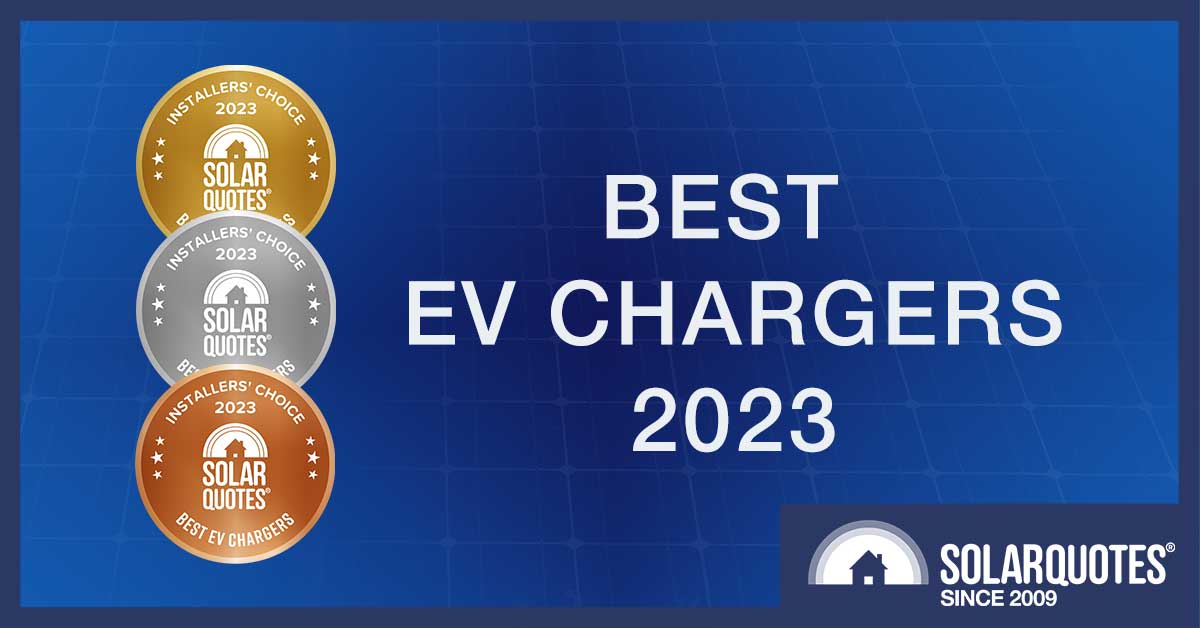 Every year we ask more than 500 installers in the SolarQuotes network which solar products they would trust in their own homes. This year, as well as asking about solar panels, inverters and batteries, we added a rapidly growing sector: electric vehicle (EV) chargers.
Every year we ask more than 500 installers in the SolarQuotes network which solar products they would trust in their own homes. This year, as well as asking about solar panels, inverters and batteries, we added a rapidly growing sector: electric vehicle (EV) chargers.
We asked three questions to tease out the best home EV charger brands in Australia for both big spenders and the budget-conscious:
- Which EV charger brand would you install on your home if money was no object?
- Which EV charger brand would you put on your home if money was tight and every dollar counts?
- Which home EV charger brand offers the best after-sales support?
It’s worth noting a significant number of installers voted ‘none,’ which likely reflects the relative inexperience of solar installers with EV chargers compared to solar panels, inverters or batteries. So, brands could get on the podium with very few votes.
Now, you may have noticed I’m calling these products “EV chargers,” while the technically correct term is “EVSE” (Electric Vehicle Supply Equipment). The actual charger is in the car, but since most laypeople call them “EV chargers,” I decided to keep it simple and stick with that.
Here are the results:
Installers’ Choice 2023: Best Home EV Chargers in Australia
Best EV Chargers 2023 Winner: Fronius
Interestingly, Fronius is not primarily an EV charger brand. Fronius is best known for solar inverters, welding and industrial lead-acid battery chargers. But Fronius do offer the Wattpilot EV charger – which comes in 3 versions, all untethered: 11KW, 22kW, and a portable 22kW unit.
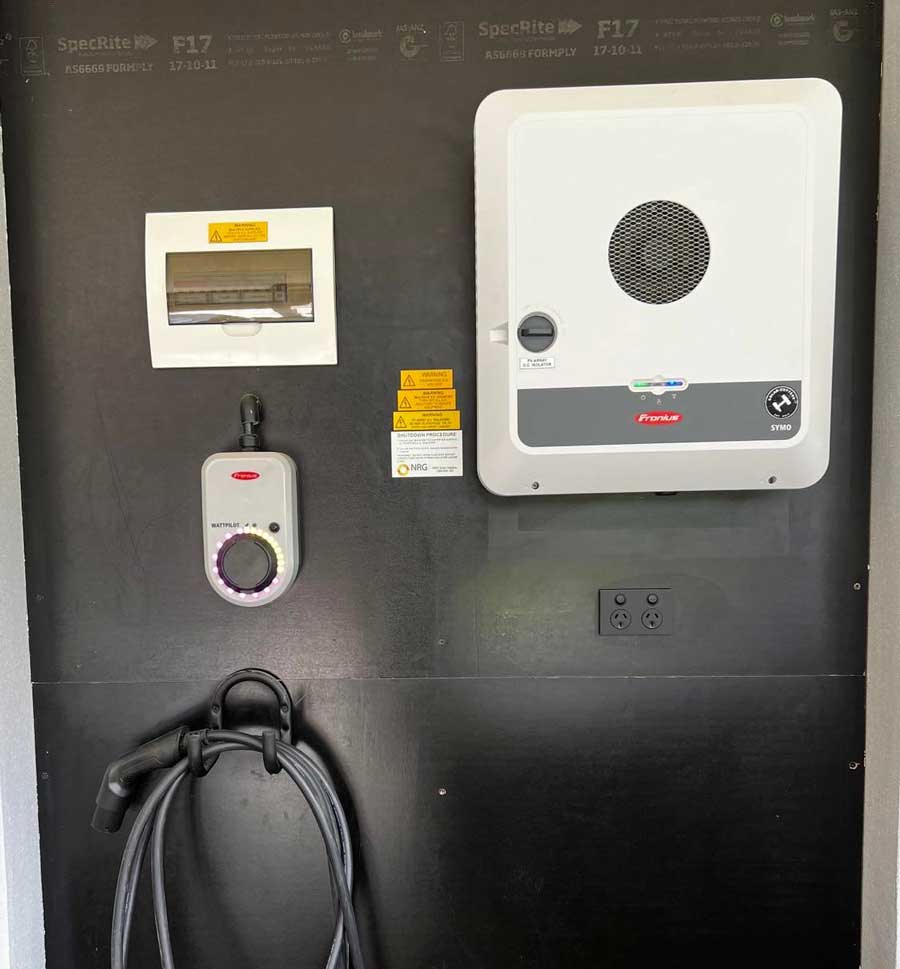
An Australian Wattpilot installation next to a Fronius Gen 24 inverter. The Wattpilot is bottom-left, just above the coiled charging cable. Image: NRG Solar
Ronald has written up a detailed Wattpilot review here. Bear in mind you should buy a 22kW unit, no matter how slow your car AC charges at – read Ronald’s post to discover why.
The portable version is a nice feature for people who expect to park in places offering an industrial power socket:
The Wattpilot is a sensible choice if you own a Fronius inverter with a Fronius Smart Meter. That’s because the Wattpilot relies on the Fronius Smart Meter to do ‘solar smart charging’, where you only charge from excess solar power. According to the installers I talked to, it is a piece of cake to commission a Wattpilot with a Fronius solar system and works well without the need for yet another bulky current transformer in your meter box.
If you don’t own a Fronius inverter, I would not recommend a Wattpilot. Although you may still be able to solar smart charge using the Wattpilot’s OCPP software interface, it’s a safer bet to buy a charger not specifically aimed at Fronius owners.
Interestingly, the Wattpilot is not manufactured by Fronius1 but by fellow Austrian company Go-e.
The Fronius Wattpilot retails at around $1,800 plus installation. Installation cost will mostly depend on how much cable needs to be run and whether you need much switchboard work.
Sadly the Wattpilot is only warranted for two short years. Sad face.
Best EV Chargers 2023: Second Place – Myenergi
Myenergi is an English company founded in Grimsby in 2016. Their current home EV charger offering is the Zappi 2, available in 7kW single-phase or 22kW 3-phase. Each version can be either tethered with a 6.5m cable or untethered.
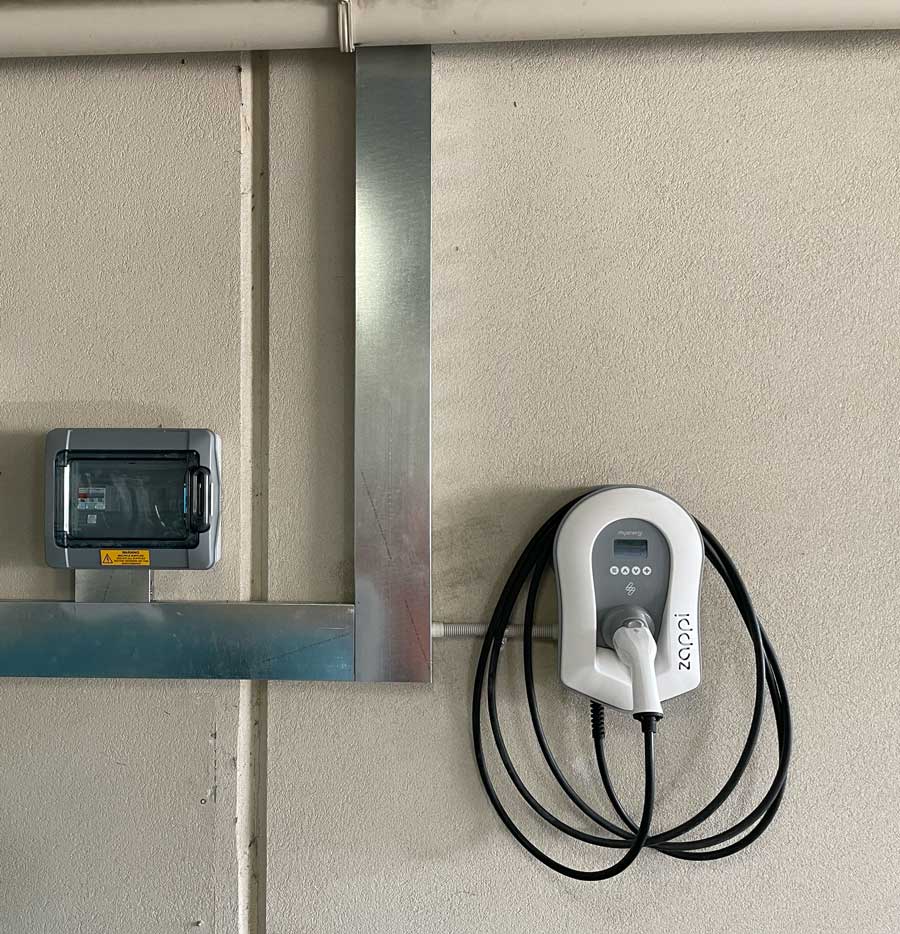
A myenergi Zappi 2 installed in an Australian garage.
The Myenergi Zappi 2 does one thing well: solar smart charging using a current transformer (CT) in your switchboard2. The CT can be hard-wired or wireless by buying a ‘harvi’ wireless transmitter box3.
One big miss in the Zappi 2’s spec is no OCPP compatibility. This means you can’t use it with third-party controllers or apps such as ChargeHQ that rely on OCPP to control and monitor the charger4. If you want to integrate your Zappi 2 into a home automation system in the future – or with a dynamic tariff, the lack of compatibility with this open standard will greatly reduce your options to do that.
Zappi fans will be pleased to learn that according to this consultancy, myEnergi appears to be working on OCPP compatibility for future Zappis. Smart move.
Update September 2023: Zappis are now OCPP compatible.
Something to watch out for if you decide to buy a Zappi: ask your installer for a Zappi with built-in WiFi. Myenergi has only just started putting WiFi into the Zappi 2s in the UK, and I suspect there is a lot of stock in Australia that does not have built-in WiFi yet.
Zappi 2s cost about $1,300 for the untethered single-phase version up to around $1,700 for the 3-phase tethered version, and are warranted for three years.
Best EV Chargers 2023: Third Place – Tesla
Tesla’s ‘Gen 3 Wall Connector’ is sleek, low-cost and simple. A bit too simple, in my opinion – as it lacks native solar-smart charging and OCPP, and you can’t buy an untethered version. It comes with a 7.3m cable.
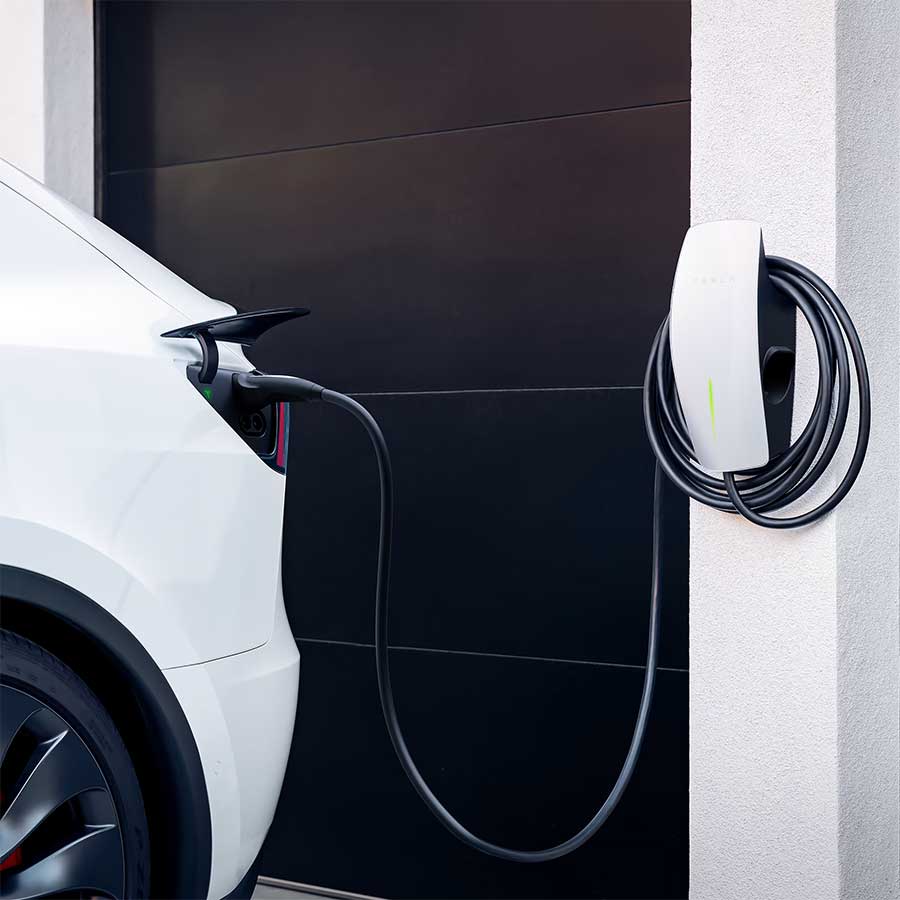
The Tesla Gen 3 Wall Connector. The home EV charger from Tesla.
The Tesla Wall Connector will charge any EV, not just Teslas, and is reliable. There is only one model. It can be configured for single or three-phase supplies.
Last week Tesla released a software update in the US that allows smart solar charging – but only if you own both a Powerwall and a Tesla car. This is something Tesla owners in Australia have been able to do with the Charge HQ app for ages.
Don’t buy a Tesla charger if you want smart solar charging for a non-Tesla. It won’t work. But if you want a home charger without any smarts for non-Tesla car owners, the Tesla Gen 3 Wall Connector is hard to beat – it’s cheap and reliable; at only $750 plus installation.
Best Value EV Chargers In Australia 2023
The ‘best value EV chargers’ podium contains all the ‘best’ winners but with Tesla and MyEnergi swapping places – probably reflecting that the Tesla device is much cheaper. It shows how immature the EV charger market is in Australia, with installers mostly sticking with the same three well-known brands. Also, note the very low vote counts. Does this suggest most installers think home EV chargers are too expensive, considering they are pretty simple devices?
Home EV Chargers: Best After Sales Support In Australia 2023
Fronius strikes again, grabbing the top spot for the best after-sales support in Australia. It seems their customer service is as top-notch as their chargers. MyEnergi and Tesla follow, again leaving no room on the podium for the other EV charger manufacturers.
So there you have it. Congratulations to Fronius, MyEnergi, and Tesla for outstanding performances in the Installers’ Choice Awards for 2023. While some installers may still be getting acquainted with electric vehicle chargers, it’s clear that these brands are leading the way in Australia’s home EV charger market in 2023.
And isn’t it just amazing how much Australian solar professionals love Fronius? Next thing you know, they’ll be getting Fronius tattoos. Oh, wait…
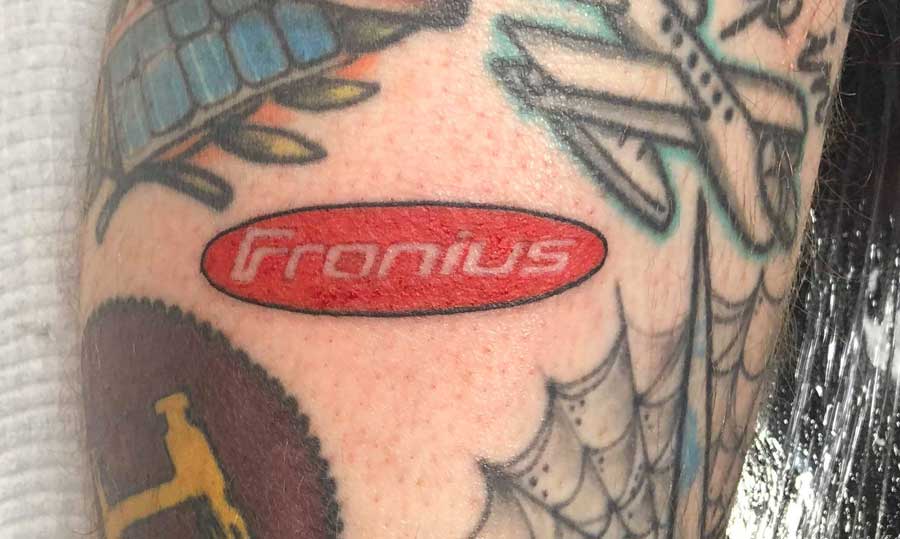
Image credit: Jack ‘Longy’ Long
Discover everything you need to know about EV charging in my 101 guide (which includes the brands I recommend); and you can compare home EV chargers side-by-side here.
Also check out other SolarQuotes Installers’ Choice Awards 2023 results; for the best solar panels, best home batteries and best inverters – as voted by Australian installers.
Footnotes
- Hat tip to Mark Stevens in this comment. ↩
- Or three CTs if you have 3-phase, or four CTs if you have 3-phase and a single-phase battery. ↩
- Although if you have to run power from the switchboard to the Zappi, you might as well run the CT cables too. ↩
- If you will only ever charge Tesla vehicles, OCPP is not required as you can bypass the charger entirely and talk to the Tesla car directly via the Tesla API – but bear in mind this is not officially supported by Tesla and access could be pulled at any time… ↩

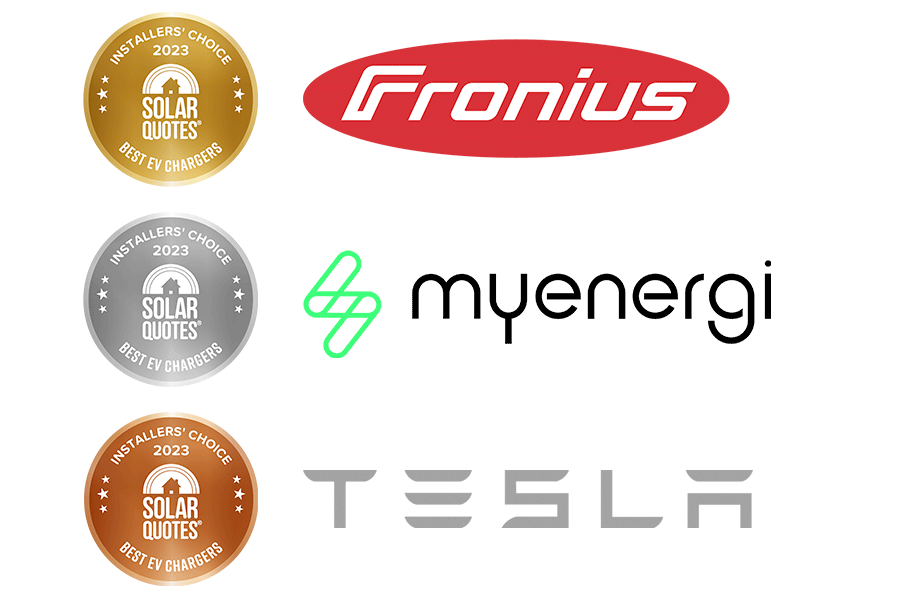
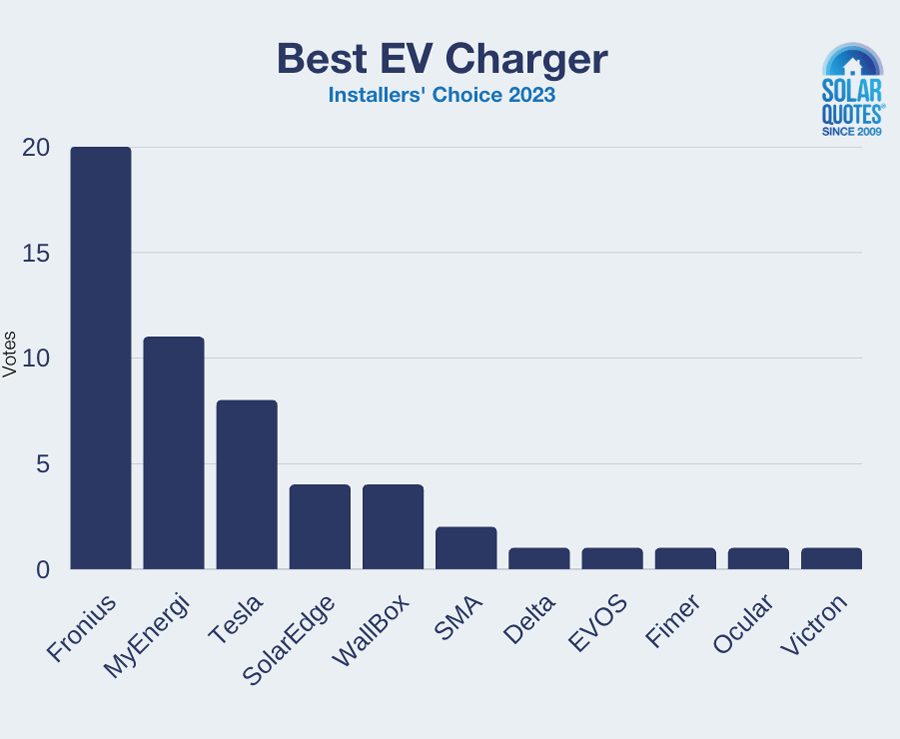
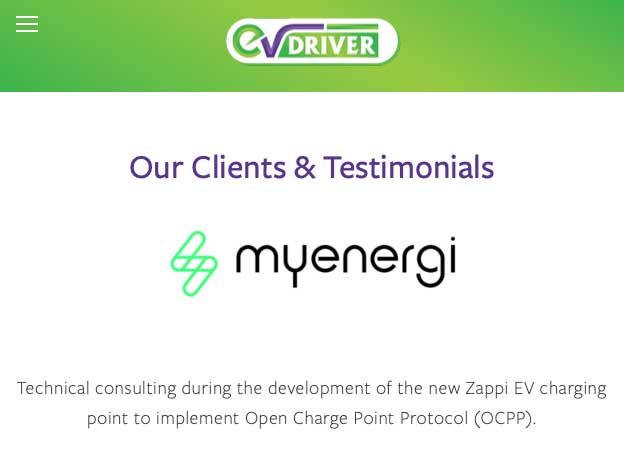
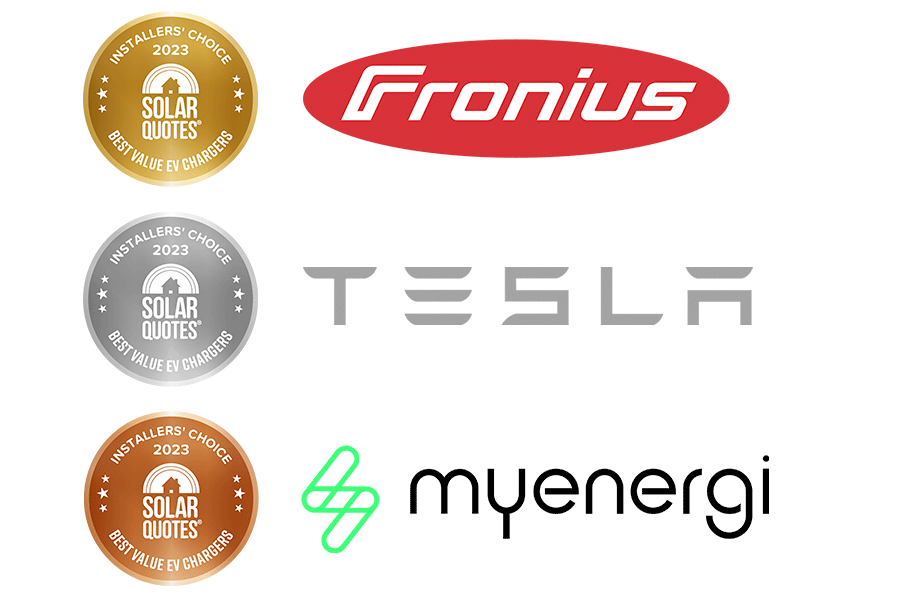
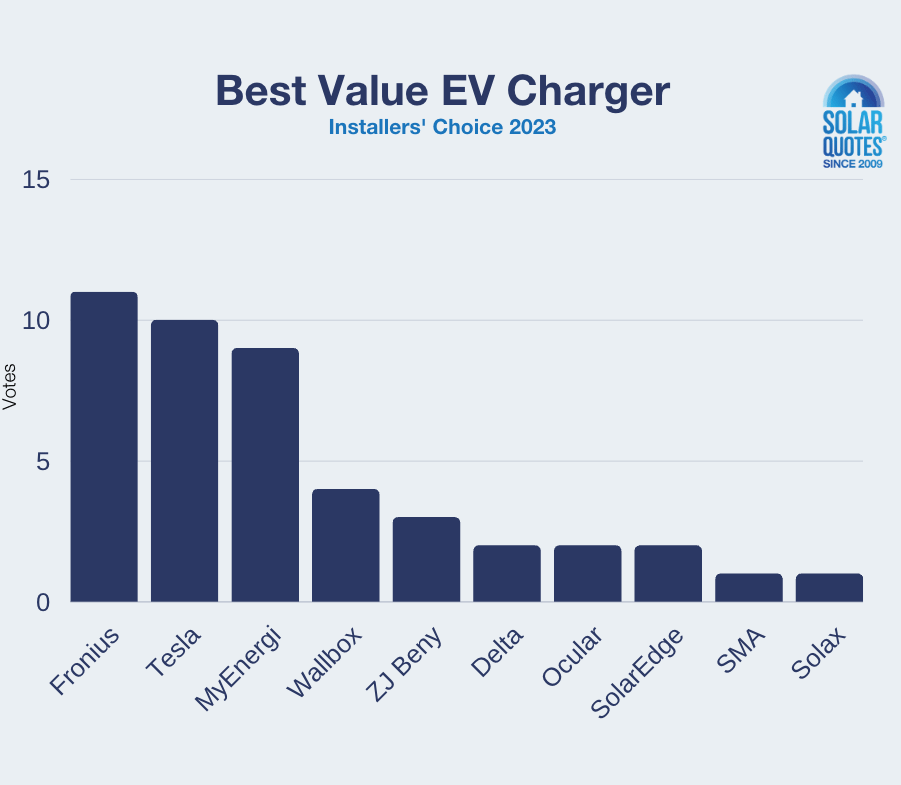
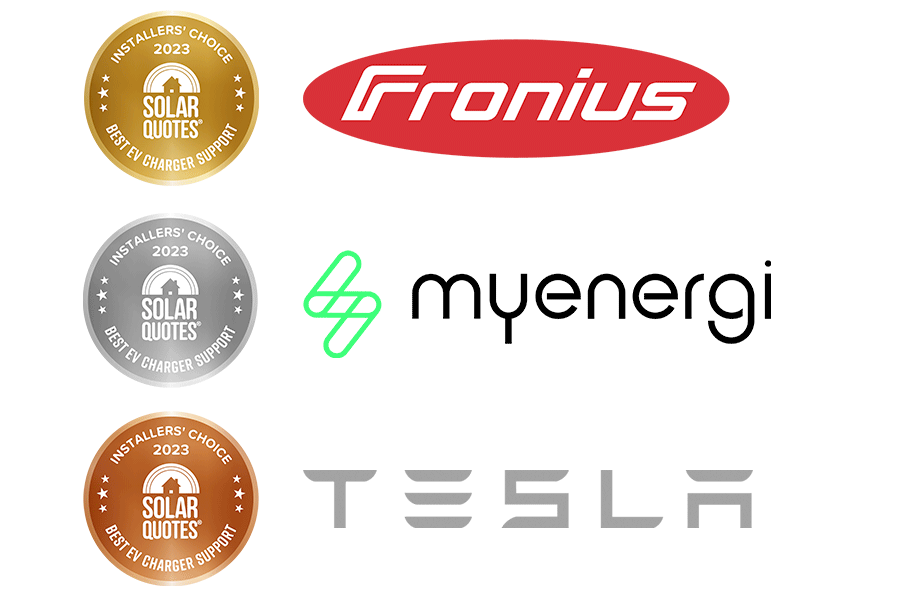
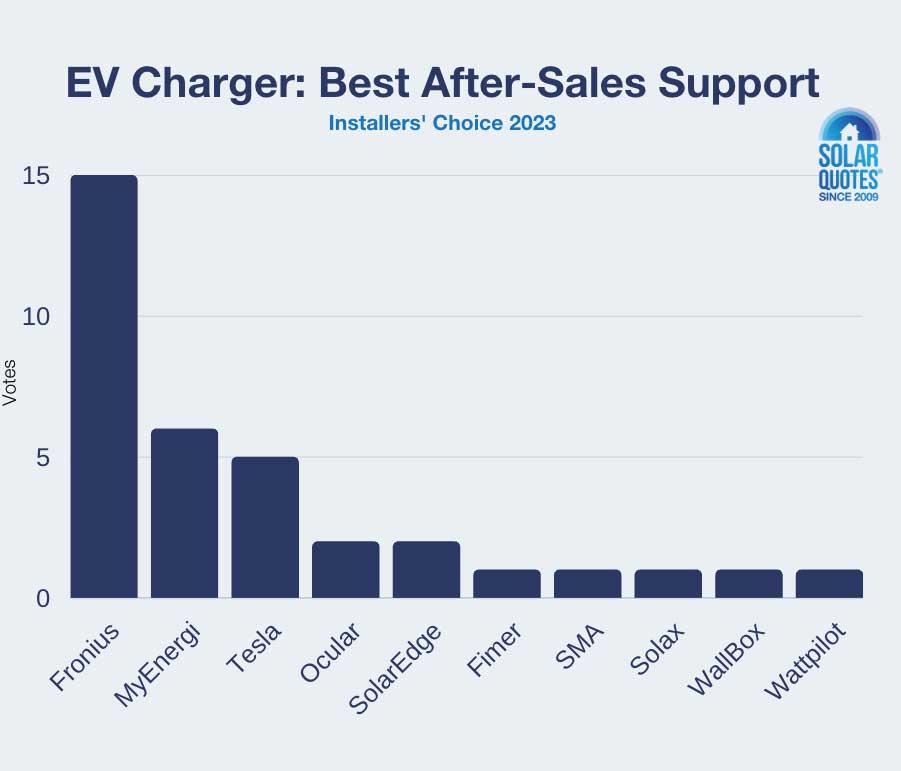
 RSS - Posts
RSS - Posts



I have been looking at the Smappee charger, but by the look of it does not even feature on the radar of your installers? I wanted a decent charger, which supports smart feartures to charge from solar, but also OCPP to enable me to fall back to a wider range of platforms and give me a better chance of integrating it with other things. Putting these things together knocks out the top plays here (and probably most of the others). I had been thinking about the Zappi, but lack of OCPP was a bit of a show stopper until we get a bit more confidence that might land in any Zappi brought today. Another reservation is if my memory serves me correctly Finn reported some reliability issues with the Zippi he brought for himself (might be wrong)?? Or is that old news and we can ignore based on the installers endorsement?
Anyway, I would be interested in any insights into this and Smappee in Australia?
I don’t know enough about the Smappee to comment meaningfully, except that they seem very focused on load management.
I had a bad experience with the Zappi 1. The Zappi 2 seems better, but personally I’ll take a lot of convincing after my Zappi 1 experience.
I replaced my warranty relacement Zappi 2 with a Delta AC Max Smart – which is OCPP compatible and works well with ChargeHQ. I’m very happy with the Delta.
I moved my Zappi 2 to an investment unit’s garage. I wanted to protect it from the elements!
Zappi 2.1 is out now with wifi and OCPP, so all good. I double checked with my installer thanks to this article – very helpful.
Overall an excellent summary Finn – although I’d love to hear your thoughts on other brands.
If you have solar then MyEnergi is great – but only if you’re going to buy into their ecosystem. An Eddi for hot water diversion, a Harvi for app compatibility etc. Note – I don’t know if they are selling the WiFi version of the Zappi in Australia yet – you still need to buy a hub for that. I asked about this when I had mine installed a couple of months back.
“The Zappi with the internal WIFI will be available in Australia by the middle of 2023 if not before.” a bit vague but there you go.
Tesla is the best value if you don’t need OCPP – and out of the top three it’s only the Fronius WattPilot that supports it. A 22kW EVSE for just $750 – less than half the price of the other brands. And it comes with a very generous 7.3M cable. And if you own a Tesla it works well with ChargeHQ (I’ve tested it). Apparently if you devote the time you can also hack the energy sharing function to supply charging based off solar.
I think the only reason the Fronius got gold is because you did it via solar installer feedback. Naturally a solar installer is going to go for a solar brand – especially one that they can get a better wholesale deal on and one that is easy to install with the most common system (Fronius). I give it points for OCPP compliance and I take points away for not offering a tethered version. Which makes it expensive but I think they are all overpriced except for the Tesla.
Contact [email protected]
The Fronius and Tesla aren’t as viable for those who don’t drive a Tesla or have a Fronius inverter. Take this into consideration and myenergi are on top in every category
Exactly, This survey is classic case of bias from installers because of their other products hence they are pushing or liking an ecosystem of fronius Otherwise Zappi should be winning hands down.
Although I chose the Zappi for my home I don’t necessarily agree 100%. If you don’t need to charge with excess solar then the Tesla is by far the cheapest (less than half the price) and the V3 will work with any CCSType 2 EV. Price has to be a consideration in any purchase decision. And although it’s not supported you can use software to control the charge rate of any EV by hacking the Tesla EVSE’s power sharing feature.
And while I agree that the only reason the Fronius got such a high rating is the survey was done with solar installers it doesn’t necessarily make the Fronius a bad EVSE. It’s the only one of the three that is OCPP compliant which means theoretically if you are with a retailer like Amber you could be getting paid to charge your EV when prices go negative. I just think there are slightly cheaper OCPP compliant EVSE’s out there.
I am surprised at the comment as my three year old Tesla Wallcharger will not work on non Tesla vehicles. I understand it may require reprogramming. Is this correct?
Some Tesla wall chargers are locked to Tesla vehicles, others can be set into a legacy mode via internal dip switches to support other manufactures. They seemed to change their mind back and forth so its hard to tell which actually support non tesla vehicles. In legacy mode the charger will try the Tesla protocol first then revert to something the rest of the world understands to initiate charging.
The Gen3 might be more open to other vehicles than Gen2 chargers.
Interestingly I nearly bought the Tesla UMC, their mobile charger for our car and get 3 phase tails for country road trips but down in the fine print of the terms and conditions it said it should only be used with Tesla’s even though I have used a friend’s one to charge our Hyundai.
The Gen 1 Tesla charger has a flip switch built in that allows it to charge all EV
Gen 2 can only charge Tesla
Gen 3 can charge all with App control after installation.
Hi Finn. I had a look at all 3 recommendations and not sure if one would really suit what we would like to achieve. We don’t have a Fronius inverter so that would rule out that option from what I read in your article. When we get an EV we wanted to charge either using excess solar, and / or off peak tariff as necessary, but was wondering how to automate this either via the wall charger or an App. If we were to say install a 7 kw or 11 Kw home AC charger, without any control, then I imagine when charging our EV during the day we will often exceed our solar production, and draw in the extra electricity needed from the grid at peak and shoulder rates. We would have to be up or remember to switch on the charging for the Off peak rate late in the evening. The 2nd recommendation seems like it might sort out the issue of only charging from excess solar, but doesn’t seem to cover being able to automate charging when the off peak tariff comes in at night. And for the 3rd choice Tesla, we don’t own a Tesla power wall, and likely our EV won’t be a Tesla, so that seems to rule out having control over charging from excess solar production, and does’t seem to cover controlling charging for when off peak rates apply. Is there a solution out there that meets what I was hoping to achieve?
Richard – you want an OCPP compatible inverter combined with the ChargeHQ app – see our comparison table for OCPP compatible products: https://www.solarquotes.com.au/electric-vehicles/compare-ev-chargers/
Hi Richard
Zappi does allow timed charging on off peak tariffs but as it is not OCPP compliant it can’t take advantage of someone like Amber who offers live low rates.
Tesla doesn’t need the Powerwall to offer excess solar charging using ChargeHQ… provided your EV is a Tesla. You will need a solar inverter that is on ChargeHQs list of compatible inverters. This is a requirement of using ChargeHQ in any case. If your only EV is a Tesla and you don’t need to divert solar to other loads and your inverter is supported by ChargeHQ then the Tesla Wall charger is the best and easiest option.
Zappi is more of an ecosystem but the lack of OCPP compatibility is likely to be limiting in Australia. Not straight away but eventually.
Fronius is OCPP compliant so apart from having a Fronius inverter you can also manage it with OCPP.
Hi folks
Have just been through the quote process for EV chargers for my 2023 BYD Atto 3 and chiming in to say that since this excellent blog post, Myenergi has come through and the Zappi 2.1 has both wifi and OCPP.
I was also hunting for something that could do excess solar during the day AND cheap rate grid overnight AND let me block my battery so I didn’t have to drain it in order to use the cheap overnight power.
Zappi 2.1 ticked all the boxes for me. Maybe worth an update to the post, Finn?
Slighlty off topic…
The Telsa charger shows the cavle coiled up in the charger while plugged in and potentially charging the vehicle.
Should the cable be un-coiled while in use, to avoid heat and resistance increase due to electromagnetic induction?
I just want one that can charge using EXCESS solar only. Is that too much to ask?
At a reasonable price would be nice as we usually get fleeced on tech downunder.
Many EV chargers have a ‘solar only’ mode – check out our comparison table: https://www.solarquotes.com.au/electric-vehicles/compare-ev-chargers/
The zappi does this straight out of the box
Hi Jojo, I agree with you…. I’m disappointed to say that I have a full Solar System comprised of QCELLS panels (x24) , a QCELLS Inverter capable of charging my QCELLS 2 x 6.8Kw batteries and at the same time routing surplus to the grid, but I don’t even have a surplus Solar based solution that you are looking for…..However, I just noticed today…..19th feb 2024 that QCELLS also have a EV charger called QCELLS Q.HOME EDRIVE A but its not in the EV charger comparison even though QCELLS was a previous winner of “best solar” categories. Is it so hard to simply get power that will be routed back to the grid when the batteries are fully charged to be routed to the car EV charger and manage the whole mess with the “clunky” QHOME app?
PS: I’m not installing 3 phase so I will be limited but accept to a single phase 7Kw (32amp) charging solution for any EV I choose to purchase.
One important feature has been ignored in this post: Automatic single phase/three phase switching to optimize excess solar power charging. Most EV won’t charge at less than 6A, so on 3 phases you need at least 4.2 kW excess power to start charging. On 1 phase, the car starts charging at 1.4 kW. Smart EVSE can charge on 1 phase up to 4.2 kW (excess PV), then switch to 3 phases. Vice versa in the evening.
Tesla can’t do this at all, Zappi has been promising the feature for years without delivering, Fronius and SMA EV charger can handle it with most EVs. Really useful if you have 3 phase electricity.
Agree, it would be handy if SolarQuotes very useful EV charger comparison table included the availability of this capability on 3-phase solar chargers. Thanks for sharing your results. I can confirm phase-switching works on the Fronius Watt Pilot and is essential for solar charging with a 3-phase EVSE.
Agreed – we’ll get it done
Thanks!
The zappi will dynamically switch between single phase and three phase in ECO modes. From firmware update v5.403 onwards
SA power has its EV charger smart approval app to have any 7kw ev charger installed at home. The pre requisite is OCPP interface in the EV charger. As most of the popular EV charger like the Tesla gen 3 stil has no OCPP interface, how do others managed to have it installed and output 7kw. Thanks.
The article talks about a software update (in USA) that allows Telsa cars to “smart charge” when combined with Tesla battery (which happens to be my setup). Is this available here now? Is it a sensible alternative to an OCPP charger, and some external software? My inverter is Goodwe not Fronius, and my system is 3-phase with 20kW.
Word on the street is that the Tesla software update that allows solar smart charging with Tesla wall connector + Powerwall + Tesla Car will be come to Australia ‘soon’.
If the wall charger is connected on the grid side of your house, rather than between the battery and your house (per some diagram I saw here?), then won’t that restrict the Tesla to charging either from the grid, or from solar-export? And charging or not can be controlled via tesla app/api? The reason I keep looking at this is that it’s less than half the hardware price of Evos or the Fronius (with Victron “coming soon” on OCPP).
per the second diagram at https://www.solarquotes.com.au/blog/ev-draining-home-battery/
Hi Finn
Trying to find out about IP ratings of the different devices – tried to find out about the specs on the different websites.
My charger will hang on the south wall on the side of my house EXTERNAL.
Any ideas?
Our EV Charger Comparison Table has an ‘IP Rating’ row.
Yes, sorry, I saw that comparison just after I sent my first reply 🙂
I am having my 10.56KW solar installed next week. I am planning to have a wall charger installed that can be integrated well with solar system. What can by my best options here ?
Also should I be asking to install separate industrial socket (allowed max with 1-phase system ie.e 15Amps, 32 Amps) just as a backup for future
What’s your solar system spec (inverter brand)?
Where do you live?
What brand cars do you need to charge?
It depends on your inverter brand.
Go with a Zappi!
Great integration with Solar, easy to use app.